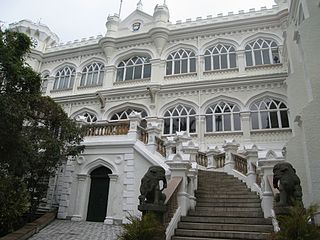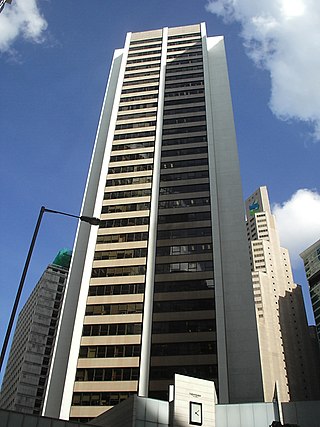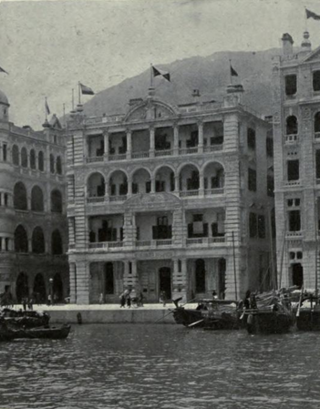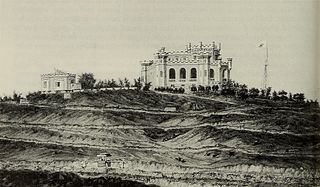
APL, formerly called American President Lines Ltd., is an American container shipping company that is a subsidiary of French shipping company CMA CGM. It operates an all-container ship fleet, including nine U.S. flagged container vessels.

Robert Swinhoe FRS was an English diplomat and naturalist who worked as a Consul in Taiwan. He catalogued many Southeast Asian birds, and several, such as Swinhoe's pheasant, are named after him.

The Hongkong and Shanghai Banking Corporation Limited, commonly known as HSBC and formerly known as HongkongBank, is the Hong Kong-based Asia-Pacific subsidiary of the HSBC banking group, for which it was the parent entity until 1991. The largest bank in Hong Kong, HSBC operates branches and offices throughout the Indo-Pacific region and in other countries around the world. It is also one of the three commercial banks licensed by the Hong Kong Monetary Authority to issue banknotes for the Hong Kong dollar.

The island of Taiwan, also commonly known as Formosa, was partly under colonial rule by the Dutch Republic from 1624 to 1662 and from 1664 to 1668. In the context of the Age of Discovery, the Dutch East India Company established its presence on Formosa to trade with the Ming Empire in neighbouring China and Tokugawa shogunate in Japan, and also to interdict Portuguese and Spanish trade and colonial activities in East Asia.

The Pacific Mail Steamship Company was founded April 18, 1848, as a joint stock company under the laws of the State of New York by a group of New York City merchants. Incorporators included William H. Aspinwall, Edwin Bartlett, Henry Chauncey, Mr. Alsop, G.G. Howland and S.S. Howland.

Hong Kong and Whampoa Dock was a Hong Kong dockyard, once among the largest in Asia.

The Japanese invasion of Taiwan, also known as Yiwei War in Chinese, was a conflict between the Empire of Japan and the armed forces of the short-lived Republic of Formosa following the Qing dynasty's cession of Taiwan to Japan in April 1895 at the end of the First Sino-Japanese War. The Japanese sought to take control of their new possession, while the Republican forces fought to resist Japanese occupation. The Japanese landed near Keelung on the northern coast of Taiwan on 29 May 1895, and in a five-month campaign swept southwards to Tainan. Although their advance was slowed by guerrilla activity, the Japanese defeated the Formosan forces whenever they attempted to make a stand. The Japanese victory at Baguashan on 27 August, the largest battle ever fought on Taiwanese soil, doomed the Formosan resistance to an early defeat. The fall of Tainan on 21 October ended organised resistance to Japanese occupation, and inaugurated five decades of Japanese rule in Taiwan.

The British Consulate at Takao is a former British consulate built in 1865 in Gushan District, Kaohsiung, Taiwan. It has been designated a historic site by the Ministry of Culture.
SS Hsin Wah, now also known as the SS Xinhua, was a steamship owned by China Merchants Steam Navigation Company, navigating between Canton City, Hong Kong, and Shanghai. She was built in 1921 by Napier & Miller in Glasgow. The ship was seized by pirates of Bias Bay in 1928 and saved by the SS Zhongshan. She sunk in 1929 when grounded on northern rocks of Waglan Island south-east of Hong Kong Island, with a loss of between 300 and 400 lives.

Tamsui District is a seaside district in New Taipei City, Taiwan adjacent to the Tamsui River and overlooking the Taiwan Strait. The name of the district means "fresh water" in Chinese. Although modest in size, Tamsui plays a significant role in Taiwanese history and culture.

University Hall, or UHall, is a historical residential hall for males at the University of Hong Kong. University Hall is one of the oldest residential halls under the university's hall system and houses about 110 students. Its hall colours are green, black and silver. It is located at 144 Pok Fu Lam Road, close to the Pok Fu Lam Reservoir within the Pok Fu Lam Country Park on the western side of Hong Kong Island.

Alexandra House is an office building in Central, Hong Kong near Central station.

The 1906 Hong Kong typhoon was a tropical cyclone that hit Hong Kong on September 18, 1906. The natural disaster caused property damage exceeding a million pounds sterling, affected international trade, and took the lives of around 15,000 people.

Shewan, Tomes & Co. was one of the leading trading companies in Hong Kong and China during the late 19th and early 20th century.

The Chinese Association for Relief and Ensuing Services, formerly the Free China Relief Association, is a non-governmental organization headquartered in Taipei, Republic of China (Taiwan). The organization specializes in forced migration, refugee assistance and disaster relief.

SS Fatshan was a passenger ferry steamer which sank in stormy seas off Lantau Island during Typhoon Rose resulting in the loss of 88 lives.

Douglas Lapraik was a British watchmaker, shipbuilder and shipping magnate of Scottish origins, most famous for his business empire and his role in the founding of many of Hong Kong's early conglomerates such as HSBC.
Gyoun Maru was an auxiliary transport of the Imperial Japanese Navy during World War II.
















